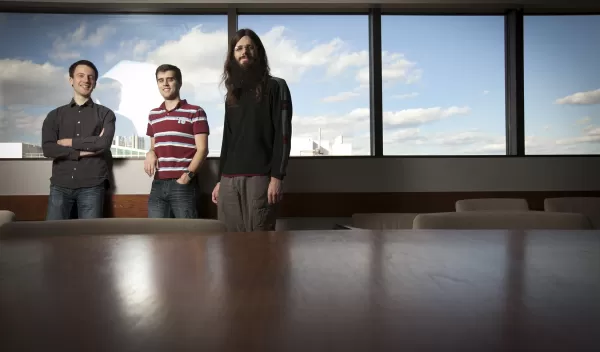
'Blockbuster' science images
At this point, the blockbuster movie Interstellar has created such a stir that one would almost have to be inside a black hole not to know about it. And while the science fiction thriller may have taken some liberties with science to make its Hollywood plot work, the imagery comes straight from science--National Science Foundation (NSF)-funded science, in fact.
Similar in premise to many other science fiction films, something sets Interstellar apart: Many of the images are--for the most part--scientifically accurate, based on lensing calculations produced by Cornell University and California Institute of Technology scientists that show what black holes or wormholes look like.
"Gravity bends the path that light follows in space," said Pedro Marronetti, an NSF program director for gravitational physics. "The stronger the gravitation, the more dramatic its effect."
Four graduate students who work in NSF-funded, Cornell astronomy professor Saul Teukolsky's group--Andy Bohn, François Hébert, William Throwe and Katherine Henriksson--as well as NSF-funded Caltech researchers Mark A. Scheel, Nicholas W. Taylor and undergraduate Darius Bunandar--have been doing related research and recently published their work about binary black holes on an online repository for scientific papers called ArXiv. The paper, "What Would a Binary Black Hole Merger Look Like?" immediately garnered media attention, including in Nature.
In the plot of Interstellar, Earth is dying; to save the human race, astronauts and scientists search for a new planet via a wormhole, essentially a shortcut through space to find a giant black hole at the other end.
Interstellar producers sought to make visual representations of the wormhole as accurate as possible. They worked closely with Kip Thorne, a theoretical physicist at Caltech and the film's executive producer, who gave the special effects team the scientific equations to create a reasonable facsimile of a wormhole.
Thorne's involvement in this gravitational lensing project led him to talk with the three Cornell grad students and their Caltech collaborators. The research of Bohn, Hébert and Throwe "on visualizing colliding black holes by gravitational lensing is very interesting and important," Thorne said.
Wormholes do not actually exist in space, but black holes do, Throwe said, so the students created two short videos for Thorne, which showed what moving by a black hole in space would look like. It would be impossible to move through an actual black hole, they said, because the pull of gravity would tear a person apart.
"We know [interstellar travel through wormholes is] kind of crazy, but it makes a good story," Throwe said.
Thorne used the students' videos to help explain to the special effects team what kinds of information would be needed to make the visualizations believable.
"It's a really small part of what they were doing, but it was really fun for us to do," Bohn said.
While much is known about what a single black hole would look like in space, little was known about what two merging black holes would look like. New technology allowed the students to do that for their paper.
"The idea that you're going to be one of the first people to look at what a merging pair of black holes would look like is a good incentive to keep going," Hébert said.
Astronomers haven't been able to visually observe black holes because nothing can escape from them, not even light or radiation. They can only be studied by noting their effects on nearby objects. That's what makes this recent research so important--because it creates a new visualization.
The team is excited about their research and hopes it will inspire even more studies. "It will be a stepping-stone for us to look into more complicated problems," Bohn said.
NSF's Marronetti added, "It is very exciting to see young researchers' work contributing to and represented in a blockbuster movie. I hope it will inspire more film directors to incorporate scientifically-based visualization in their movies."
NSF's Ivy Kupec contributed to this story.
